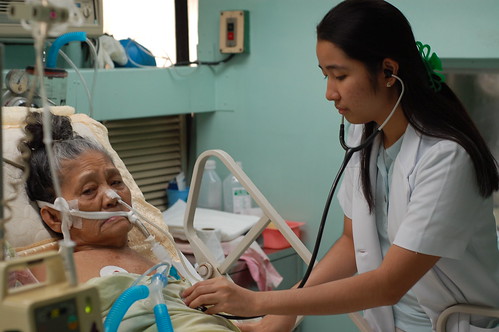
Welcome to the Middle of Nowhere and the 3rd Edition of The Blog Rounds!
Before anything else, I'd like to thank all the medical bloggers who participated in this edition of The Blog Rounds for their enthusiastic response. Many new voices have been added this week - and I am hoping this won't be the last time they will be joining our particular chorus! Given the very personal nature of the topic for the week, the honesty and candor of all the bloggers have made it a joy to read the stories they have chosen to share.
Now, I would like to help them share their stories with all of you.
Without further ado, I bring you TBR 3 - At a Crossroads.
****
The nitty-gritty of the pursuit to the elusive M.D. and beyond is a mystery to most. In Crossroads and Crossed Roads, Dr. Em Dy sets the stage by detailing the major crossroads in every doctor's life.
There are as many reasons behind the choice to pursue a medical career as there are doctors. But as Doc Tes skeptically points out in her native Cebuano, one favorite reason given by aspiring medical students in their interviews is the catch-all reason, "To Serve Humanity."
Given the difficulty of the journey, the choice to continue is presented to one time and again, and, ultimately, not everyone decides to go into clinical practice or even to finish medicine. Kitty Mama was once a doctor-in-training who made the choice to leave that life for a new one. In Margarita, she talks about her experience of being exposed to the hospital for the very first time - one event that she used to sustain her during her stay as a medical trainee. Bubbleman, on the other hand, chooses the Other road much later in his medical journey. In On Choices, he attempts to tell us why he is no longer practicing medicine and to connect the dots of his choices into a pattern that makes sense.
Being at the cusp of a new phase in your life, on a new road you have chosen, can both be exhilarating and terrifying. Merry Cherry, a young doctor to the barrio, recalls the terrifying feeling of anticipation before her deployment and shares her thoughts on where she is more than a year after she first began this particular journey. In Roadkill, new graduate Kai describes the feeling of literally being in the driver's seat for the first time and makes this experience a metaphor for her life in the near future. Doc Whisperer shares with us a poem about the changes that can follow making a choice in Crossroads.
The end of any chapter in a doctor's life always leads to a crossroad - which can sometimes translate into a dead end. In my post, "Stop, World, I'm Getting Off!," I explain my choice to slow down a career that is going too fast for my liking in order to figure out where I want to go. Manggy describes the end of medical school as his Pre-Life Crisis and draws a blank on what to do next as he stands at the crossroads of choosing where to practice medicine. Angel-No-More finds herself at a crossroads of a different sort, as she comes to some realizations upon reaching the big 3-0.
To others, however, coming to a crossroads when one reaches the end of their training causes their life to open up. Midnight Rainbow, in her post Ang Biyahe ng Buhay Ko, likens her life to a highway and talks about the stops and detours that have led her to where she is today - and a future full of possibility. In her first ever Blog Rounds post, Lei Si talks about why she chose medicine and the "everything else" she wants to do now that she's found her life's calling.
Sometimes the choice of the road to take is dictated by circumstance, Fate, or some Unseen Hand. Abner Hornedo chronicles his meandering journey from choosing one specialty and ending up in another in Fate Sometimes Decides. In Megamom's Two or Three, she recalls making a major life decision influenced by her being a woman of science - but whose final outcome was wonderfully orchestrated by God. Ness, a practicing anesthesiologist, shares her experience as a doctor who studied nursing as a second course - but is still practicing medicine in the Philippines.
Sometimes we try to reassure ourselves that we are going the right direction by looking for "signs" along the way. Prudence blogs about the "signs" she has looked out for during her journey through medicine and wonders if they are really worth watching out for.
There are some whose paths have led them to where they feel they are meant to be and are content with the choices they have made. Doctor Joey, another ophthalmologist, talks about some of the major crossroads in her life and her satisfaction with their outcomes. In his post Babies, Bulbuls, and Bonsai Trees, Doc Noel learns of the joys of coming home and the freedom of starting his own private practice in General Santos City. Bone MD recounts his long arduous journey through medical school to starting his present practice as an Orthopedic surgeon in the hinterlands of Mindanao in Nowhere to Go But Up.
We cannot touch on the topic of the choices doctors make and not touch on the controversial diaspora of Filipino doctors to other lands. Often, medical workers are perceived as "the bad guy" in the deteriorating health condition of the country today without being given a chance to have their say. But why do doctors leave? Their stories may be different, but their reasons are surprisingly quite alike.
Dr. Doray of Doralicious is now serving as a councilor in Quezon City - but two years ago she was actually planning to train abroad. Tongue-in-cheek, she shares with us the plans she made then and the reasons behind them, before Fate stepped in and changed them all. With dry wit, RG recounts his impulsive choice to begin a new journey in the land Down Under and the reasons behind his decision in All is Quiet on New Year's Day. Another young MD, AnnKat, talks about how a change in plans does not equal a change of heart in Exodus. Finally, Dr. Martin Bautista, Filipino doctor and former senatorial candidate, blogs about his choice to train and start a practice abroad and how his experiences and his desire to serve have led him back home.
The theme "At a Crossroads" was a bid to uncover the people behind the white coat for non-medical readers while at the same time giving us medical people a common ground from where we can find new insights into our own lives through the experiences of others on the same journey. I hope that this collation of posts was able to do both.
Many thanks for participating - and see you next week at Doc Tes's place for TBR 4 with the interesting topic of The Doctor as Patient!

Click here to read the rest of this post.
























